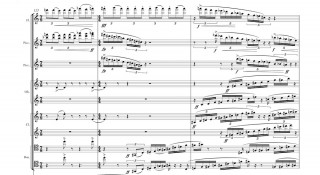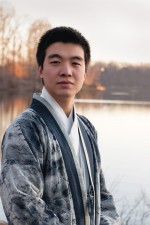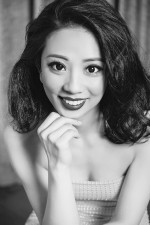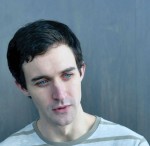Title

Fragment of Theo Chandler's Songs From Brooches. Chandler has pieces in both the Orchestra and N.J.E. concerts.
April kicks off with two concerts of student compositions. On the 3rd, Jeffrey Milarsky conducts the Juilliard Orchestra in pieces by four students, and the next night, Joel Sachs leads the New Juilliard Ensemble in premieres of works by the winners of the ensemble's spring audition for Juilliard composers plus works by Tajikistani-Canadian composer Farangis Nurulla-Khoja's Ravishi Nur (Transmission of Light) and Korean-German composer Unsuk Chin's Gougalon. The students shared some thoughts about their work.
Body
Doctoral student Ross S. Griffey (MM '14, composition)
Essay, Juilliard Orchestra
Essay for orchestra references American composer Samuel Barber's three works of the same name. Like those essays, my piece explores the ramifications of a musical idea within the confines of a concise form. Essay derives its energy from a single motivating conflict: the tension between the orchestra as a single unit and the orchestra as made up of numerous individual musicians. The opening of the work raises this issue immediately, as an orchestral outburst gives way to a quartet of solo strings. The idea of orchestra versus individual then plays out across the piece, with virtuoso passages for the principal players and moments of disorder in which orchestral unity threatens to give way to willful soloists.
Formally, Essay consists of two large sections. The lyrical first section alternates between woodwind solos and string passages, culminating in a lush restatement of its primary melodies. An interruption by the brass triggers the vigorous second section, in which both soloists and groups toss intricate passagework to one another, vying for primacy. A thunderous climax elicits the dissolution of the orchestra into its constituent parts, and a pair of clarinets, a cello trio, and the harp see the piece to its subdued conclusion.
First-year master's student Chen Yihan
Dr. Edmond Lipton Memorial and Albert Szirmai scholarships
Dust, Juilliard Orchestra
Suddenly, there is nothing in the world that's not a flower. No growing; no withering; there is only the perpetual blossoming. But suddenly, there is nothing in the world that's not rain. No sun shining; no snowflakes drifting; there is only the perpetual vanishing.
The sea surface is ever calm, and the sky is ever expansive. Within that stretch of blue, we are blind to the flame so distant below. The sun rises after the rain, and blossoms drift on the ocean surface. Within that stretch of red, the waves carry them toward the unknown.
Rather than searching for the spotless mirror, I would become that dust. Rather than receiving everlasting life, there is no more to life than this moment.
Second-year master's student Shuci Wang
Dr. Edmond Lipton Memorial and Edward Steuermann scholarships
Abyss (Arthur Friedman Prize), Juilliard Orchestra
Although frequently changing in character, Abyss is built around two ideas that are stated in the opening bars. The first is an assertive four-note motif beginning with a descending perfect fourth and is heard first in pizzicato strings and later in longer values in the trumpets. The second is an expressive melody with big rising leaps introduced in the trombones. These two ideas—or elements taken from them—are heard in many guises throughout the work. In the broadest sense, the piece can be said to contain three main sections: a fast, driven, dizzying opening; leading to a slow, hazy, more dreamlike middle section; and finally a return to the more driven material that culminates in an assertive and forceful conclusion. This involves dramatic shifts from violent to tranquil passages utilizing the independent motifs throughout. My aim was to express an immeasurable dark space, an infinite gulf.
Second-year master's student Theo Chandler
Frank Damrosch and Juilliard scholarships
Marvin Hamlisch Scholarship in Composition
Songs From Brooches, Juilliard Orchestra
Songs From Brooches uses texts from the collection Brooches, by New York-based poet Zeke Greenwald. I became acquainted with Zeke and his poetry by chance after a performance at a puppet theater in Brooklyn. In this piece, the sopranos share the spotlight, sometimes alternating lines from the poems, sometimes resonating or amplifying each other. The four movements offer the vocalists opportunities to demonstrate a wide range of technical ability; each movement highlights a specific instrument or group from the orchestra as a partner to the soloists.
The first movement features a trio of flutes that encircles the sopranos as they glide through the text; only in the last two lines of the poem does the rest of the orchestra enter. The strings accumulate gradually, leading to a large swell that contrasts the miniatureness of the preceding music. Movement two features bright, jittering ostinatos and frenetic repetition of short motives, and the vocalists lose their lyricism and become a single entity. An obstinate bass drum solo at the end of the movement winds down to a low rumble to introduce movement three, which alternates between a rhapsodic string octet and a fragile oboe duo. Over the course of the movement, the oboes lose primacy to a trio of Harmon-muted trumpets. The movement as a whole has little urgency—each vocalist and instrument is given time to luxuriate in curvilinear melodies. The final movement begins in the floating character of the preceding one. This does not last long, though, as the music plunges into a middle section marked by thick, weighty chords. Particularly notable is the use of tuba to double the vocal line many octaves below.
Tragedy No. 2 (2017), New Juilliard Ensemble
Recently I have become interested in writing pieces that do not at first reveal their true nature—pieces that give a false first impression. In Tragedy No. 2, that interest manifested itself as a tension between two genres: ensemble music and concerto. I imagined a piece that initially acts like an ensemble piece, meaning it has mostly equal balance of importance between the members of the group, until it becomes commandeered by a more assertive, self-important entity. A single prominent instrument suggests the genre of concerto, while the stage setup, concert program, and first few minutes of the piece suggest the genre of ensemble music. I think the concerto is one of the few sacred, uncorrupted definitions of a genre that remains from common practice era, so it is an interesting element to unravel; defying the nature of the dichotomy between concerto and ensemble piece still seems meaningful to me.
Doctoral student Jonathan Cziner
C.V. Starr Foundation Doctoral Fellowship
Transient Bodies, New Juilliard Ensemble
I was born with an astigmatism in my left eye, a fairly common defect caused by an irregular curvature of the cornea, which results in distorted images as light rays are prevented from meeting at a common focus. I also sustained severe trauma to my right eye in a rather damaging sports accident at a young age. Since this accident, I have experienced what are known as entoptic phenomena—visual effects whose source is within the eye itself. Transient Bodies is a reflection on both my physical experiences with these phenomena as well as how I've coped psychologically with them, as they ultimately make me aware of my mortality and fragile nature.
The music itself tries to encapsulate these entoptic floaters and flashers by way of meandering and wandering running lines, first appearing in the vibraphone and then moving to different instruments within the ensemble. I've orchestrated this material in such a way that they create a blurry and unclear, yet oddly comforting impressionistic sound world. This is juxtaposed with a biting dotted rhythmic motive, which represents my psychological and existential ruminations as a result of these entoptic phenomena.
I've always favored a rich lyricism in my writing, however, I've found that in this piece, I've taken a slightly different approach. With Transient Bodies I felt the need to abandon this lyricism, instead favoring orchestrational gesture and harmony built out of intervals.









